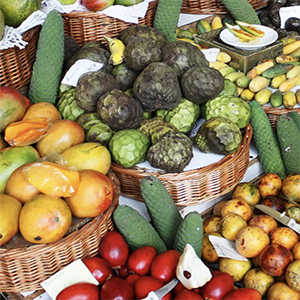Antimicrobial of tropical fruit and vegetable waste extract for food-borne pathogenic bacteria

Accepted: 1 September 2022
HTML: 43
All claims expressed in this article are solely those of the authors and do not necessarily represent those of their affiliated organizations, or those of the publisher, the editors and the reviewers. Any product that may be evaluated in this article or claim that may be made by its manufacturer is not guaranteed or endorsed by the publisher.
Authors
Tropical fruit and vegetable wastes become great potential natural resources of bioactive compounds for antimicrobial. The aim of the study was to determine the effect of antimicrobial extracted from tropical fruit and vegetable waste to inhibit foodborne pathogenic bacteria (Aeromonas hydrophilla, Bacillus cereus, Escherichia coli, Listeria monocytogenes, Salmonella Typhimurium, Staphylococcus aureus, Vibrio parahaemolyticus). A total of six tropical fruit waste (peel of pineapple, jackfruit, durian, coffee, mangosteen, and cacao pods) and five tropical vegetable waste (stem of sembukan, lamtoro pods, jengkol shell, bitter bean pods, Indian marsh fleabane leave) was extracted by using maceration method. The antimicrobial activity of extracts was carried out by using disc diffusion assay and Minimum Inhibitory Concentration. The flavonoids in extract were identified and quantified by using Liquid Chromatography-Mass Spectrometry. The highest antimicrobial activity against Gram-positive bacteria (B. cereus, L. monocytogenes and S. aureus) was shown by jengkol, bitter bean and mangosteen waste extract in the range of 0,00038 to 4,2% for MIC. The highest antimicrobial activity inhibits Gram-negative bacteria (A. hydrophilla, E. coli, S. Typhimurium and V. parahaemolyticus) was shown by jengkol, bitter bean, mangosteen, sembukan and lamtoro waste extract in the range of 0,00038 to 3,1% for MIC which have apigenin, catechin, coumaric acid, gallic acid, genistein, hydroxybenzoic acids, luteolin, myricetin, naringenin dan quercetin as bioactive compounds. Total phenol of those waste extracts was in the range of 0.663 to 4,441 mg GAE/g. Jengkol, bitter bean, mangosteen, sembukan and lamtoro waste extract shown to be a potential natural antimicrobial to inhibit food-borne pathogenic bacteria.
Supporting Agencies
PNBP ResearchHow to Cite
PAGEPress has chosen to apply the Creative Commons Attribution NonCommercial 4.0 International License (CC BY-NC 4.0) to all manuscripts to be published.

 https://doi.org/10.4081/ijfs.2022.10510
https://doi.org/10.4081/ijfs.2022.10510



